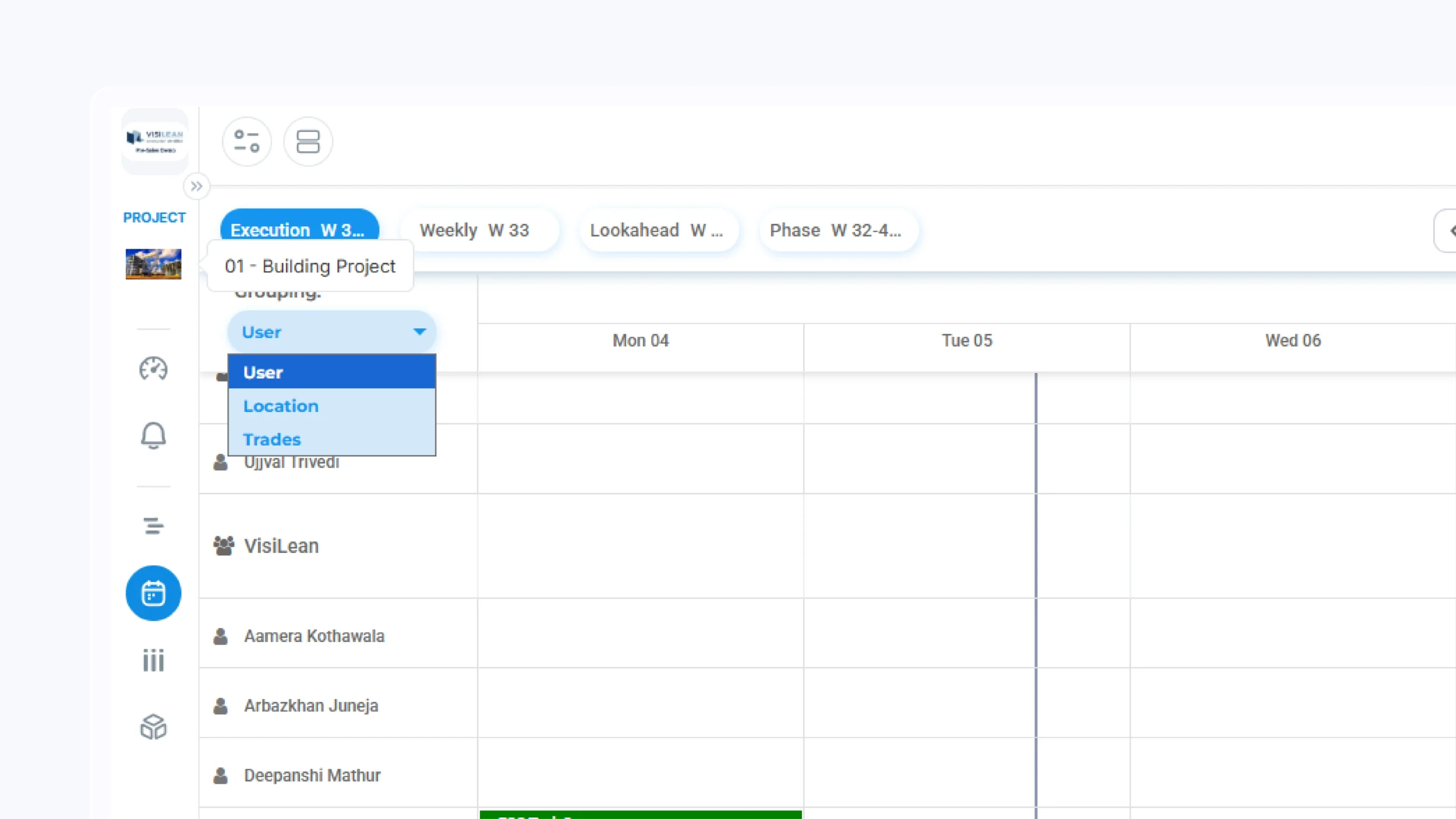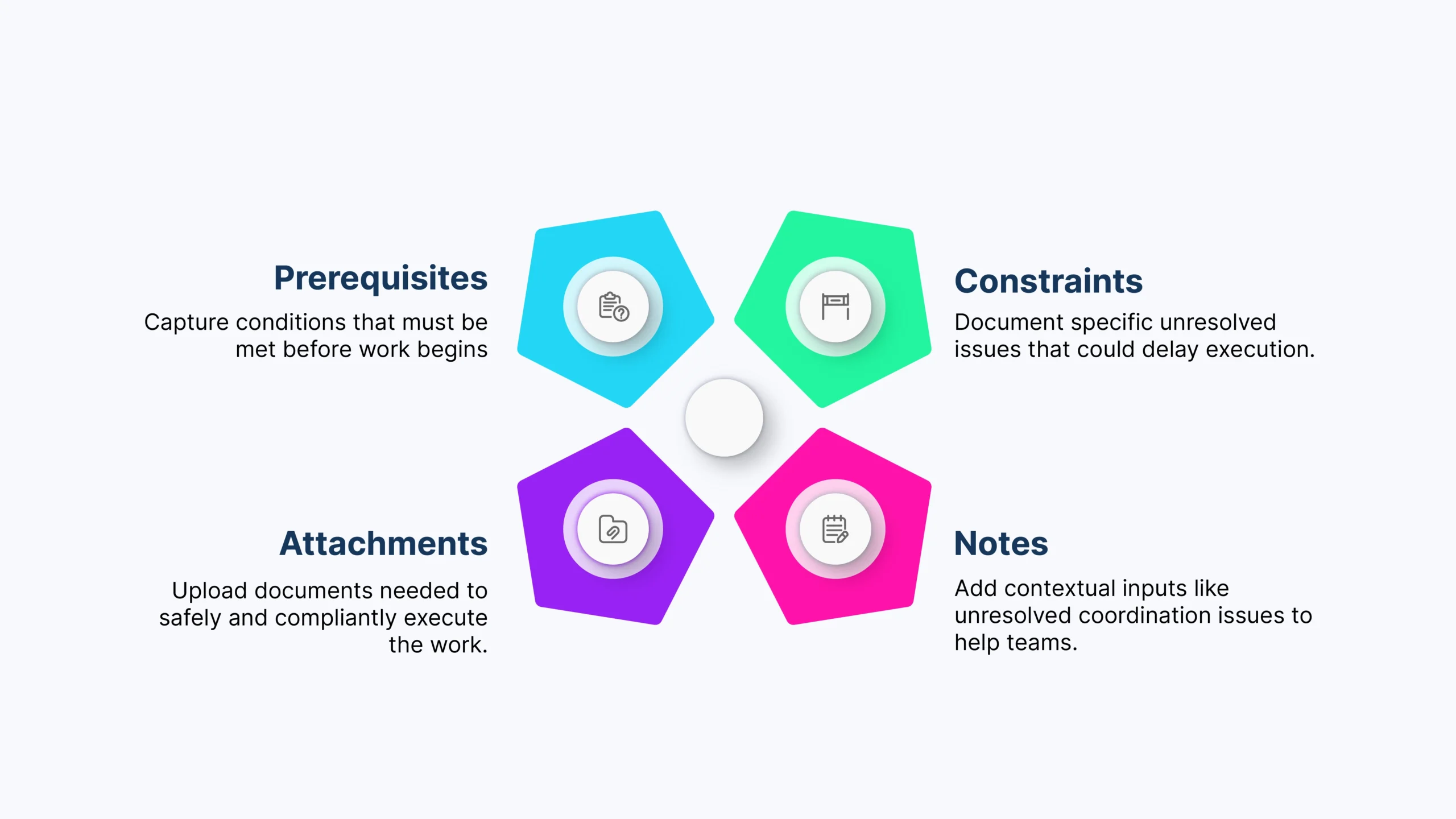Introduction
The Scheduler module in VisiLean is designed to align short-term planning with the master schedule by bringing all stakeholders onto a centralised platform. This enables teams to assign tasks with defined ownership, collaboratively agree on durations, and sequence work based on real on-site constraints.
Furthermore, by shifting planning from a static document to an interactive, role-based process, VisiLean Scheduler enhances reliability, minimises chaos, and facilitates better control throughout execution.
This blog outlines how the Scheduler helps project teams move from reactive coordination to structured and commitment-based planning, resulting in greater efficiency and more predictable outcomes.
Collaborative Planning Approach Inside Scheduler
The Scheduler in VisiLean is designed to support a collaborative approach to short-term planning, where project stakeholders jointly contribute to creating and maintaining the plan. To support this, the core mechanism of Scheduler promotes transparency, task readiness, and accountability. Below are the key components that define this collaborative process inside the scheduler.
I. Phase-Based Pull Planning and Location-Wise Task Breakdown
VisiLean’s Scheduler uses a phase-based pull planning method. This helps teams work backwards from key milestones. Teams don’t just push tasks from a static master schedule. Instead, they identify the scope for each phase. They break down the master schedule’s “should-do” items into actionable “can-be-done” tasks based on site readiness.
Key Grouping Methods
- Location: Grouping tasks by work zones avoids congestion. It also helps manage access and align activities with real spatial constraints.
- Trade: Viewing work by trade exposes interdependencies. This enables smoother handovers and reduces clashes.
- User: Assigning tasks by user improves clarity and accountability. It also helps with real-time tracking of commitments.
This structured breakdown keeps planning tightly aligned with how work gets done in the field.
II. Constraint Mapping in Lookahead
In Lookahead planning, the goal is to see upcoming tasks and ensure they are ready for commitment. Constraint mapping is a critical step. It allows teams to verify if an activity is executable in the upcoming weeks. VisiLean’s Scheduler attaches constraint information directly to each task. This helps planners and site teams map and resolve blockers in advance.
Key Fields for Constraint Mapping
- Prerequisites: Capture conditions that must be met before work begins — from approvals and resource availability to site access or preceding dependencies.
- Constraint: Document specific unresolved issues that could delay execution. These logs create a visible trail of accountability and prevent necessary blockers from slipping through the cracks.
- Attachments: Upload permits, drawings, compliance documents, or method statements needed to safely and compliantly execute the work.
- Notes: Add contextual inputs like field observations or unresolved coordination issues, helping teams with surface constraints that don’t fit neatly into structured fields.
By embedding these inputs within the planning process, VisiLean helps you ensure that Lookahead plans serve as a true indicator of workflow readiness, not just a forecast.
III. 3/4/6 Week Lookahead Planning for Execution Readiness
Once constraints are identified and logged, the next step is refining the short-term plan. VisiLean enables 3/4/6-week Lookahead Planning, giving teams a structured view of upcoming work and the foresight needed to resolve issues before they impact execution.
This planning window provides real-time visibility into tasks, helping teams detect sequencing conflicts, trade overlaps, and task interdependencies early. With this insight, planners can optimise resource allocation and align trade workflows.
With VisiLean, teams can filter tasks by readiness status, assign responsibility for constraint resolution, and track updates directly from the field, making the Lookahead plan a dynamic and living document. Tasks progress to “make-ready” only when all prerequisites—materials, permits, access, or design approvals—are cleared, ensuring reliable execution downstream.
This results in a proactive and dependable plan that improves flow, boosts Plan Percent Complete (PPC), and ensures smoother handoffs across the entire project delivery team.
IV. Weekly Work Plan with Real-Time Execution Monitoring
Once tasks have been reviewed and cleared in the Lookahead plan, they are brought into the Weekly Work Plan as committed activities. These are tasks that teams agree to deliver within the coming week.
The Weekly Work Plan in VisiLean reflects a commitment-driven approach by highlighting tasks that are genuinely “make-ready.” This ensures that planning moves from intent to execution with clarity and confidence.
During execution, teams can monitor task progress directly in the system. Real-time updates from the site – including task status, reason for delay, and progress remarks – are fed back into the schedule, providing an accurate and continuously updated picture of project delivery. This visibility enables quicker decision making, supports corrective actions, and ensures accountability to planned commitments.
V. Performance Tracking and Reporting
VisiLean’s Scheduler provides a direct export option to generate PDF or image snapshots of the schedule at any point in time. These exports capture all visible planning data — including task names, assigned teams, planned dates, readiness indicators, and commitment status — exactly as laid out in the swimlane or Gantt view.
This functionality allows project managers to quickly share the latest version of the schedule with clients, consultants, or on-site teams without needing to recreate Spreadsheets or PPT reports. Since exports are generated from the live environment, the output reflects actual progress and commitments, not outdated plans.
The exported files serve multiple use cases — from weekly client progress reviews to daily internal briefings — while preserving the full context of who is responsible, what is ready, and what is delayed. This helps ensure that everyone is aligned on priorities and accountable to the current plan.
VI. 4D BIM for Visual Scheduling and Coordination
The Scheduler in VisiLean integrates with Building Information Modelling (BIM) to enable 4D planning — linking scheduled tasks directly with elements in the 3D model. This creates a time-based visual simulation of the construction sequence, offering teams a clear picture of how the project will progress over time.
This integration helps identify spatial clashes or sequencing issues before work begins on-site. Teams can simulate activities, verify constructability, and coordinate trades more effectively by visualising the impact of each task within the actual built environment.
Beyond visualisation, 4D BIM in VisiLean supports better communication during planning meetings, improves clarity for field teams, and enhances coordination with consultants and clients. It also supports early detection of trade clashes and optimisation of resource allocation, reducing rework.
Ready to Bring Greater Reliability to Your Construction Planning?
The VisiLean Scheduler is built to fix a persistent gap in construction: the disconnect between planning and site conditions. It embeds ownership, readiness, and collaboration directly into the schedule. This turns short-term planning into a dynamic, execution-focused process.
Every feature supports one core goal: improving the reliability of project delivery. Want your construction plan to be more reliable, collaborative, and execution-driven?
Frequently Asked Questions (FAQ)
1. How does VisiLean’s Scheduler differ from traditional tools like MS Project?
Traditional tools are fine for high-level master schedules (the “should-do” plan). However, they often miss the dynamic reality of a construction site. VisiLean focuses on short-term, collaborative planning (the “can-do” and “will-do” plan). It integrates real-time feedback, constraint analysis, and trade partner commitments. This makes it a living plan for execution teams, not just a static document for planners.
2. What is “lookahead planning”, and why is it important?
Lookahead planning is a key part of the Last Planner® System. It involves reviewing tasks for the next 3-6 weeks. The goal is to identify and eliminate constraints before work begins. This proactive process ensures tasks are “make-ready” for the Weekly Work Plan. This dramatically increases plan reliability, improves workflow, and prevents delays on-site.
3. How does VisiLean help improve Plan Percent Complete (PPC)?
PPC measures the percent of planned weekly tasks that are actually completed. VisiLean improves PPC by ensuring only “make-ready” tasks are committed. The system formalises constraint mapping, helping teams resolve blockers ahead of time. This commitment-based approach, along with real-time tracking, creates a culture of accountability and directly leads to higher PPC scores.
4. Is the 4D BIM integration necessary to use the Scheduler?
No. The 4D BIM integration is a powerful feature, but it’s not required to use the Scheduler’s core functions. You can achieve huge improvements with lookahead planning, constraint management, and weekly work plans alone. The 4D component enhances these processes by providing visual context, which is extremely helpful for complex projects.
5. Who in the project team typically uses the VisiLean Scheduler?
VisiLean is for the entire project team. Typical users include:
- Project Managers & Planners: To oversee the schedule and track progress.
- Site Engineers & Superintendents: To manage weekly plans and update tasks from the field.
- Trade Foremen: To commit to tasks and provide updates on their crew’s progress.
This role-based access turns planning from a top-down instruction into a team-wide commitment.







